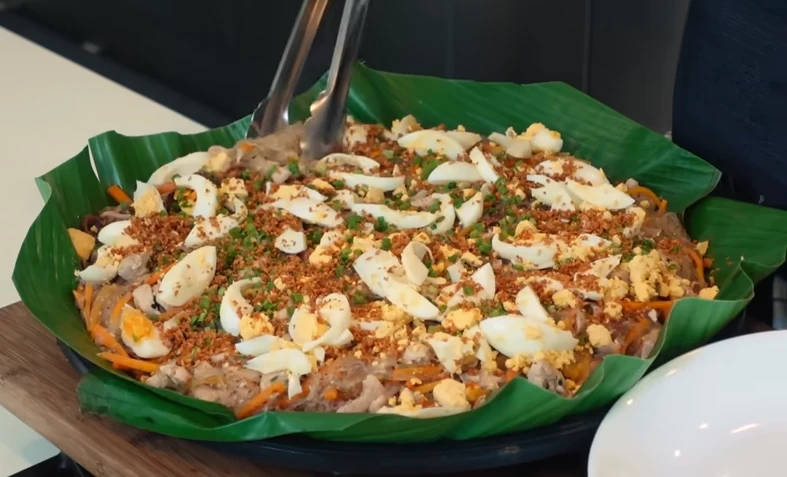Explore Sotanghon-Canton Guisado: Two Textures, One Pan
In Asian culture, noodles symbolize “long life”, maybe that’s the reason that in any event of celebration or gathering in the Philippines, the noodles are a must-have dish and will be cooked in one form or another. Sotanghon-Canton Guisado or Pancit Canton with Sotanghon Noodles are two names of the same dish that is the combination of two famous noodles, Sotanghon and Pancit Canton. The name of the dish is also derived from these two noodles with the addition of “Guisado” which means “sautéed”, so the name dish literally means “sautéed Sotanghon and Pancit canton.”
As the name of the dish indicates, it is full of noodly goodness so how can Amber stay behind to serve this dish in its Pancit section? Amber’s menu offers the dish with a special touch without compromising on the quality as well as flavor. You can enjoy the dish by going to any branch of Amber restaurant or by ordering online. But if you are away from the Philippines or just want to cook the dish at home, you can follow the recipe I shared in this article and enjoy this festive noodle dish.
Prices:
| Serving Size | Price |
|---|---|
| Single Order: | ₱ 75.00 |
| 3-5 Persons: | ₱ 540.00 |
| 6-10 Persons: | ₱ 750.00 |
| 11-15 Persons: | ₱ 850.00 |
| 16-20 Persons: | ₱ 950.00 |
| 21-25 Persons: | ₱ 1050.00 |
Recipe of Sotanghon-Canton Guisado
This super yummy dish is like a pinoy version of Chow Mein and has canton and Sotanghon as the main ingredients along with pork, chicken, shrimp, and vegetables, which may vary as per one’s choice and flavor. Canton are a kind of noodles that are yellowish in color and are made of wheat flour and eggs, while Sotanghon are glass-like, thin, and transparent noodles with a springy delicate structure. Sotanghon noddles are made of mung bean starch.
To cook this crowd-pleasure dish on any occasion from the comfort of your home, follow the detailed recipe below. You will need some more ingredients other than these noodles which I will discuss in detail.

Ingredients
- 250 grams thinly sliced pork belly
- 1 (227g) pack of Pancit canton noodles
- 1 (250g) pack of dried vermicelli Sotanghon noodles
- ½ Napa cabbage, thinly sliced
- 1 cup Baguio beans (green beans), trimmed and cut into bite-sized pieces
- 2 red bell peppers, thinly sliced
- 2 carrots, julienned (thinly cut into matchsticks)
- 1 onion, chopped
- 3 cloves garlic, minced
- 1 tablespoon freshly ground black pepper
- ¼ cup soy sauce
- 1 cup water
- ¼ cup cooking oil
- 1 teaspoon all-purpose seasoning (or to taste)
Instructions
- Take a pan and put it on the stove to preheat it.
- Add pork belly. Cut into bite-sized pieces before adding to the pan.
- Spread the meat pieces evenly on the pan surface and cover the pan so they cook evenly. Cook until golden brown.
- When cooked, take the pork out of the pan and keep in a bowl or any pot for later use.
- In the same pan, add onion to saute. Stir for half a minute and then add garlic.
- Add green beans (Baguio beans) to the pan when the onion, and garlic mixture is cooked and caramelized. Stir well and leave still for 20 seconds.
- Add carrots and mix for 30 seconds, then again leave it for 20 seconds and add napa cabbage.
- Add 1 teaspoon of all-purpose seasoning, 1 tablespoon of coarse black pepper, ¼ cup of soy sauce, and toss all the vegetables until they are mixed well. When mixed, take the vegetable out of the pan instantly (can’t afford overcooked vegetables in this dish). Leave a bit of the mixture in the pan for the next step.
- Now add 2 cups of water to the pan and add both the noodles, i.e., Pancit canton or egg noodles, and vermicelli glass noodles.
- Add broth cube or bouillon to the mixture and mix well. Let boil until the noodles are fully cooked. This will also result in the reduction of the liquid.
- At this stage add the vegetables extracted from the pan earlier and mix well. Add red bell pepper and meat and mix well with the help of 2 spatulas.
- Your hot, savory Filipino delight is ready to serve.
Nutrition
- Calories: 400-500 (depending on the fat content of the pork belly)
- Fat: 15-20 grams (mostly saturated fat from the pork belly)
- Carbohydrates: 40-50 grams (mostly complex carbs from the noodles)
- Protein: 20-25 grams (from the pork belly and vegetables)
- Sodium: 800-1000 mg (due to the soy sauce)
- Fiber: 5-7 grams (from the vegetables)
Additional Tips
- You may customize the recipe as per your taste and nutritional requirements and add chicken breast, shrimp, tofu, or a combination instead of pork.
- You may also add chili flakes or chopped chilies to make the dish a bit spicier if you like it that way. Add them when sauteing vegetables.
- You could also try more options in vegetables like Broccoli, snow peas, or baby corn.
- Don’t forget to soak the Sotanghon noodles as mentioned on the package before cooking.
- Take special care to avoid overcooking of the vegetables.
- In case of any leftovers, Sotanghon-Canton Guisado can be stored in an airtight container for up to 3 days.
- Garnish the dish with chopped green onions, fried garlic bits, or a wedge of Calamansi or lemon.
FAQs
Sotanghon noodles are thin, translucent noodles made from mung bean starch. They have a delicate, springy texture. Canton noodles, on the other hand, are thicker, egg-based noodles with a yellow color. They have a chewier texture. Sotanghon-Canton Guisado combines these two textures for a unique and satisfying noodle dish.
Absolutely! This recipe is very versatile. You can replace the pork belly with chicken breast, shrimp, tofu, or even a combination of these proteins.
If you enjoy a bit of heat, you can add chili flakes or chopped chilies to the pan while sauteing the vegetables. Adjust the amount to your desired spice level.
When stored properly in an airtight container, leftover Sotanghon-Canton Guisado can be refrigerated for up to 3 days.
Conclusion
Sotanghon-Canton Guisado is a delicious and festive Filipino noodle dish that’s perfect for any occasion. It’s packed with flavor and features two unique noodle textures. This recipe provides a simple and straightforward way to recreate this crowd-pleasing dish at home. Don’t forget to explore the customization options to tailor it to your preferences! For an authentic restaurant experience, visit your nearest Amber branch or order online to enjoy their take on this delectable dish.







